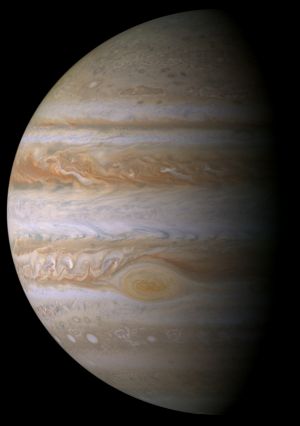
| JUPITER |
|---|
Jupiter is the fifth planet from the Sun and the largest planet within the solar system. It is two and a half times as massive as all of the other planets in our solar system combined. Jupiter, along with Saturn, Uranus and Neptune, is classified as a gas giant. Together, these four planets are sometimes referred to as the Jovian planets. Jovian is the adjectival form of Jupiter; the Greek equivalent Zeus supplies the root zeno-, used to form some Jupiter-related words, such as zenographic. When viewed from Earth, Jupiter can reach an apparent magnitude of −2.8, making it the third brightest object in the night sky after the moon and Venus. However, at certain points in its orbit, Mars can briefly exceed Jupiter's brightness. The planet was known by astronomers of ancient times and was associated with the mythology and religious beliefs of many cultures. The Romans named it after Jupiter, the principal God of Roman mythology. The planet Jupiter is primarily composed of hydrogen with a small proportion of helium; it may also have a rocky core of heavier elements. Because of its rapid rotation the planet is an oblate spheroid (it possesses a slight but noticeable bulge around the equator). The outer atmosphere is visibly segregated into several bands at different latitudes, resulting in turbulence and storms along their interacting boundaries. A prominent result is the Great Red Spot, a giant storm that is known to have existed since at least the seventeenth century. |
|
Surrounding the planet is a faint planetary ring system and a powerful magnetosphere. There are also at least 63 moons, including the four large moons called the Galilean moons that were first discovered by Galileo Galilei in 1610. Ganymede, the largest of these moons, has a diameter greater than that of the planet Mercury. Jupiter has been explored on several occasions by robotic spacecraft, most notably during the early Pioneer and Voyager fly-by missions and later by the Galileo orbiter. The latest probe to visit Jupiter was the Pluto-bound New Horizons spacecraft in late February 2007. The probe used the gravity from Jupiter to increase its speed and adjust its trajectory toward Pluto, thereby saving years of travel. Future targets for exploration include the possible ice-covered liquid ocean on the Jovian moon Europa. SATELITES Jupiter has at least 63 natural satellites. Of these, 47 are less than 10 kilometres in diameter and have only been discovered since 1975. The four largest moons, known as the "Galilean moons", are Io, Europa, Ganymede and Callisto. The orbits of Io, Europa, and Ganymede, some of the largest satellites in the solar system, form a pattern known as a Laplace resonance; for every four orbits that Io makes around Jupiter, Europa makes exactly two orbits and Ganymede makes exactly one. This resonance causes the gravitational effects of the three moons to distort their orbits into elliptical shapes, since each moon receives an extra tug from its neighbors at the same point in every orbit it makes. The tidal force from Jupiter, on the other hand, works to circularize their orbits. The eccentricity of their orbits causes regular flexing of the three moons' shapes, with Jupiter's gravity stretching them out as they approach it and allowing them to spring back to more spherical shapes as they swing away. This tidal flexing heats the moons' interiors via friction. This is seen most dramatically in the extraordinary volcanic activity of innermost Io (which is subject to the strongest tidal forces), and to a lesser degree in the geological youth of Europa's surface (indicating recent resurfacing of the moon's exterior). |
|
Opposition 2006. |
||||
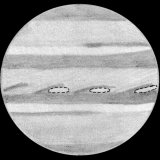 |
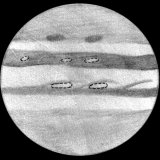 |
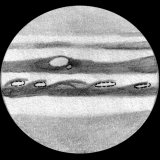 |
||
Jupiter 07.04.2006. |
Jupiter 16.04.2006. |
Jupiter 18.04.2006. |
||
Opposition 2007. |
||||
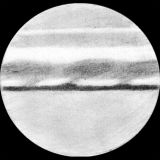 |
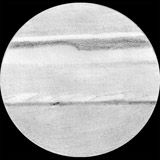 |
|||
Jupiter 08.06.2007. |
Jupiter 17.06.2007. |
|||
Opposition 2008. |
||||
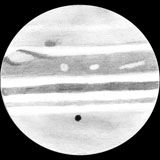 |
||||
Jupiter 21.08.2008. |
||||
VEDRAN VRHOVAC© 2006.-2007. |
